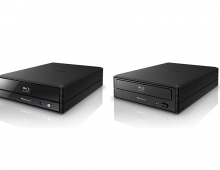
TDK gets 4x recording speed with write-Once, read-many-times disc meeting 'Blu-ray Disc' spec!
At the "ISOM/ODS 2002" conference held in Hawaii from July 7-11, TDK Corp. unveiled the results of its development of the write-once, read-many-times disc. The company is developing the disc in the hope that it will be included in the "Blu-ray Disc" specification. TDK shares the development concept of preserving the natural environment with Pioneer Corp., its development partner, and TDK took it into consideration in selecting the material for the recording layer. The company used a metallic substance for the layer. TDK also revealed the achievement of the 4x recording speed and the result of the recording/playing back test using the double-layered recording medium.
TDK has selected Si and the Cu alloy for the material of the recording layer. The new layer is made of these two substances, Cu alloy at the bottom and the Si top. According to TDK, both of them are not included in the toxic substances listed in the "Green Procurement," a unified standard set by 18 Japanese companies, including Canon Co., Ltd., Sony Corp. and Ricoh Co., Ltd.
Moreover, the two substances for producing the recording layer are not specified by the Pollutant Release and Transfer Register (PRTR) law. The low price of the two substances is another advantage. It enables the company to realize the low-cost layer production, which is essential for manufacturing write-once, read-many-times discs, the company said.
TDK sandwiches the two substances with the protective layers of ZnS-SiO2. Si and the Cu alloy will melt when irradiation of the laser raises the temperature of the recording layer. After the melted substances are cooled down, they form an alloy, which changes the reflectance of the layer. The reflectance is 13.5 percent before any data are written, which is within the limits provided in the Blu-ray Disc specification of the re-writable medium.
This time, TDK has created a 25GB disc on an experimental basis and evaluated its performance at the recording speed of 36Mbps, which is the standard speed of the Blu-ray Disc specification, and at 72Mbps, which is twice faster than the standard speed. The evaluation results showed that it was possible to hold the jitter below 7 percent in both cases.
In addition, TDK has evaluated the performance of two types of media at the recording speed of 144Mbps, which is four times faster than the standard speed. Also, it has evaluated the performance of a 50GB single-sided, double-layer, write-once read-many-times disc. In the evaluation at the 4x recording speed, the company examined the jitter of the 23.3GB disc and the 25GB disc. The result of the evaluation showed the jitter level of 5.4 percent in the case of the 23.3GB medium and 7.4 percent in the case of the 25GB medium, when the recording power of the recording-layer surface was 5mW (when using the Limit Equalizer).
The signals of the double-layer write-once read-many-times disc showed the eye pattern in the 36Mbps recording. "We confirmed the clear eye pattern. It means that we can obtain the same result if we conduct the evaluation of the 50GB disc," the company concluded.
Moreover, the two substances for producing the recording layer are not specified by the Pollutant Release and Transfer Register (PRTR) law. The low price of the two substances is another advantage. It enables the company to realize the low-cost layer production, which is essential for manufacturing write-once, read-many-times discs, the company said.
TDK sandwiches the two substances with the protective layers of ZnS-SiO2. Si and the Cu alloy will melt when irradiation of the laser raises the temperature of the recording layer. After the melted substances are cooled down, they form an alloy, which changes the reflectance of the layer. The reflectance is 13.5 percent before any data are written, which is within the limits provided in the Blu-ray Disc specification of the re-writable medium.
This time, TDK has created a 25GB disc on an experimental basis and evaluated its performance at the recording speed of 36Mbps, which is the standard speed of the Blu-ray Disc specification, and at 72Mbps, which is twice faster than the standard speed. The evaluation results showed that it was possible to hold the jitter below 7 percent in both cases.
In addition, TDK has evaluated the performance of two types of media at the recording speed of 144Mbps, which is four times faster than the standard speed. Also, it has evaluated the performance of a 50GB single-sided, double-layer, write-once read-many-times disc. In the evaluation at the 4x recording speed, the company examined the jitter of the 23.3GB disc and the 25GB disc. The result of the evaluation showed the jitter level of 5.4 percent in the case of the 23.3GB medium and 7.4 percent in the case of the 25GB medium, when the recording power of the recording-layer surface was 5mW (when using the Limit Equalizer).
The signals of the double-layer write-once read-many-times disc showed the eye pattern in the 36Mbps recording. "We confirmed the clear eye pattern. It means that we can obtain the same result if we conduct the evaluation of the 50GB disc," the company concluded.





















